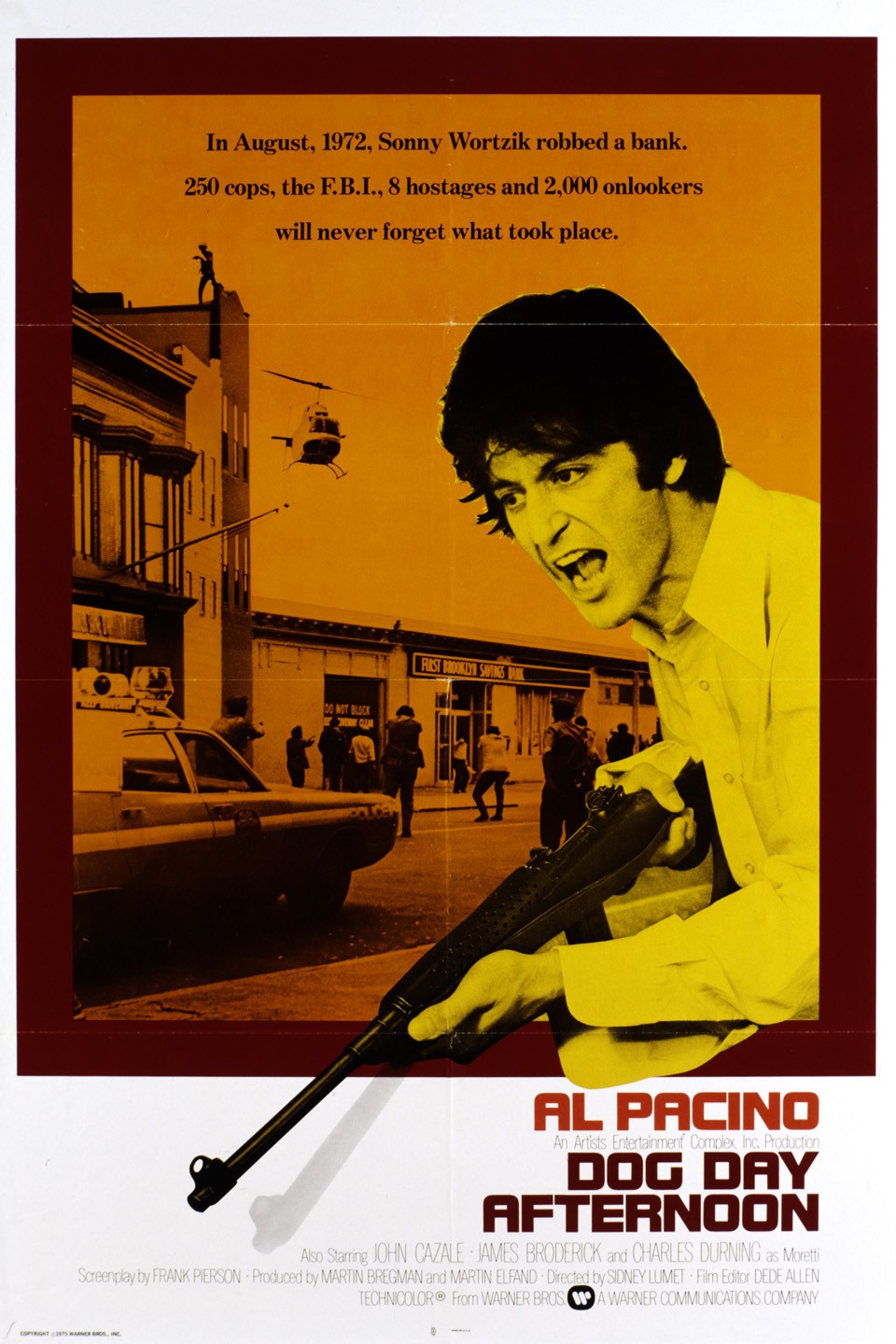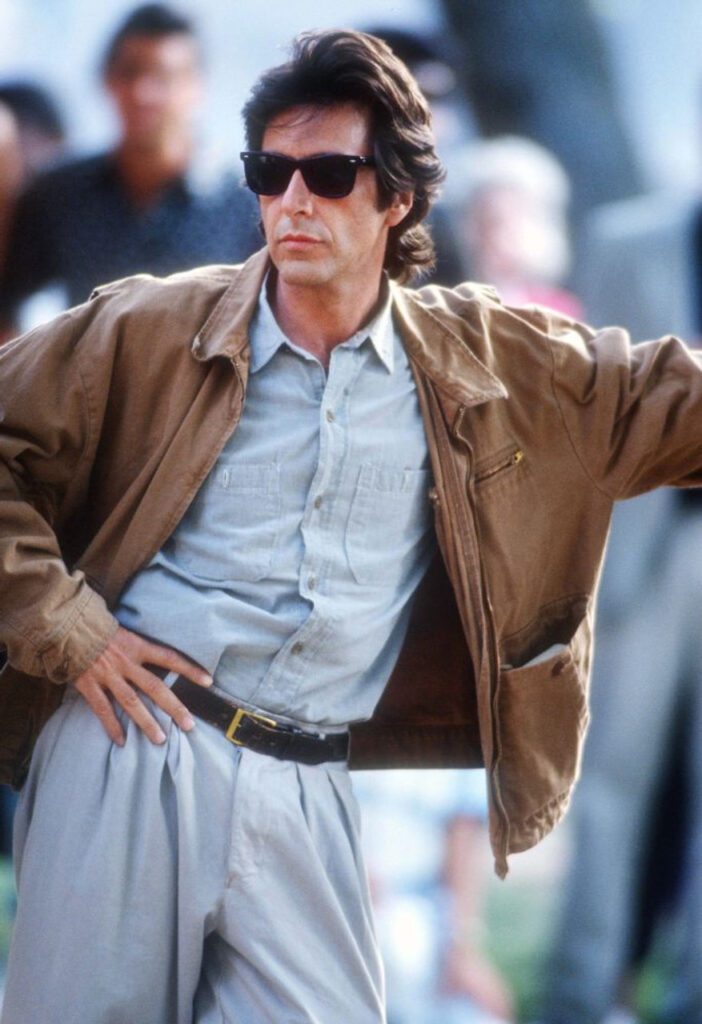“Dog Day Afternoon” (1975): A Landmark in Cinema and Social Commentary – Film Review

“Dog Day Afternoon,” directed by Sidney Lumet and released in 1975, is a film that has etched its place in the annals of American cinema. Starring Al Pacino and John Cazale, the film is based on the true story of a bank robbery gone awry, which quickly devolves into a media circus. The film not only captures the chaotic energy of the event but also delves into complex social issues, including the emerging awareness of LGBTQ+ rights. Notably, “Dog Day Afternoon” was one of the first mainstream American films to address trans issues, adding layers of depth to its narrative.
Al Pacino’s Riveting Performance
Al Pacino delivers a powerhouse performance as Sonny Wortzik, the desperate and determined bank robber. His portrayal is nuanced, capturing the multifaceted nature of a man driven to extreme measures.
- Desperation and Determination: Pacino’s Sonny is a character teetering on the edge. His initial motivation for the robbery is driven by a genuine desperation to fund his partner Leon’s gender confirmation surgery, a detail that adds a profound layer to his character. Pacino portrays this desperation with an intensity that is both captivating and heartbreaking.
- Complex Humanity: Throughout the film, Pacino infuses Sonny with a deep sense of humanity. Despite the criminal act, Sonny emerges as a sympathetic figure. His interactions with the hostages reveal a man who is caring and protective, making his predicament all the more tragic.
- Charismatic Leadership: Pacino also captures Sonny’s charisma and leadership qualities. Even in the midst of chaos, Sonny commands attention and respect, both from the hostages and the growing crowd outside the bank. His ability to negotiate and manage the escalating situation highlights his resourcefulness and tenacity.
John Cazale as Sal
John Cazale’s portrayal of Sal, Sonny’s partner in the heist, is equally compelling. Cazale brings a quiet intensity to the role, providing a stark contrast to Pacino’s more volatile performance.
- Silent Intensity: Cazale’s Sal is a man of few words, but his presence is deeply felt throughout the film. His stoic demeanor and unwavering loyalty to Sonny add depth to his character. Cazale’s ability to convey complex emotions through subtle expressions and body language is a testament to his skill as an actor.
- Vulnerability and Fear: Beneath Sal’s calm exterior lies a palpable sense of fear and vulnerability. Cazale masterfully portrays Sal’s internal struggle, making his character both enigmatic and relatable. His fear of the unknown and the escalating stakes of the robbery create a tension that permeates the film.
- Tragic Partnership: The dynamic between Sonny and Sal is central to the film’s emotional core. Cazale and Pacino share a remarkable chemistry, portraying a partnership built on trust and desperation. Their interactions highlight the loyalty and camaraderie that bind them, even as the situation spirals out of control.
Sidney Lumet’s Direction
Sidney Lumet’s direction is a crucial element in the film’s success, creating a tense and immersive experience that captures the essence of the real-life event.
- Real-Time Tension: Lumet employs a real-time narrative structure, heightening the tension and urgency of the unfolding events. This approach immerses the audience in the chaotic atmosphere of the robbery, making them feel like active participants in the drama.
- Documentary Style: The film’s documentary-like style adds to its authenticity. Lumet’s use of handheld cameras, natural lighting, and minimalistic set design creates a sense of realism that enhances the impact of the story. This technique also underscores the film’s social commentary, grounding it in the gritty reality of 1970s New York.
- Character Focus: Lumet’s direction places a strong emphasis on character development, allowing the audience to connect with Sonny, Sal, and the hostages on a deeper level. By focusing on their individual stories and interactions, Lumet humanizes the characters, making their plight more relatable and poignant.
Exploration of Trans Issues
One of the most groundbreaking aspects of “Dog Day Afternoon” is its exploration of trans issues, a topic rarely addressed in mainstream cinema at the time. The film’s depiction of Sonny’s relationship with his partner Leon adds a layer of social relevance and emotional depth to the narrative.
- Authentic Representation: The character of Leon, portrayed by Chris Sarandon, is depicted with sensitivity and authenticity. Leon’s struggles with gender identity and the desire for gender confirmation surgery are presented in a respectful and nuanced manner. Sarandon’s performance captures Leon’s vulnerability and strength, making the character a vital part of the story.
- Motivation for the Heist: Sonny’s motivation for the bank robbery is rooted in his love for Leon and the need to fund Leon’s surgery. This aspect of the plot brings attention to the financial and social challenges faced by transgender individuals, highlighting the lengths to which loved ones might go to provide support.
- Social Commentary: By incorporating trans issues into the narrative, “Dog Day Afternoon” offers a subtle yet powerful commentary on the societal attitudes and prejudices of the time. The film challenges the audience to empathize with characters whose struggles might have been marginalized or misunderstood in mainstream discourse.
The Hostages and Their Humanization
The hostages in “Dog Day Afternoon” are not mere background figures; they are integral to the film’s narrative and emotional depth. Their interactions with Sonny and Sal add layers of complexity to the story.
- Individual Stories: Each hostage is given a distinct personality and backstory, making them fully realized characters rather than faceless victims. Their responses to the situation range from fear and anxiety to empathy and solidarity, reflecting the diverse human reactions to crisis.
- Sympathetic Dynamics: The evolving relationship between the hostages and their captors is a key element of the film. As the hours pass, a strange camaraderie develops, blurring the lines between captor and captive. This dynamic adds an emotional richness to the narrative, challenging the audience’s perceptions of right and wrong.
- Human Resilience: The hostages’ resilience in the face of danger is a testament to human strength and adaptability. Their ability to find moments of humor and humanity amidst the chaos underscores the film’s exploration of the human spirit under duress.
Media Circus and Public Spectacle
“Dog Day Afternoon” also serves as a critique of the media’s role in sensationalizing real-life events and turning them into public spectacles.
- Media Frenzy: As the robbery unfolds, the media descends on the bank, turning the heist into a live spectacle. Reporters and news crews swarm the scene, eager for the latest scoop, often at the expense of ethical journalism. This portrayal highlights the media’s tendency to exploit sensational stories for ratings and public attention.
- Public Fascination: The crowd that gathers outside the bank becomes a character in its own right. Their reactions range from support for Sonny to morbid curiosity, reflecting the complex and often contradictory nature of public fascination with crime and violence. The film captures the voyeuristic thrill that such events can evoke in the public psyche.
- Impact on Events: The media’s presence and the growing crowd influence the events inside the bank. Sonny’s awareness of being watched shapes his actions and decisions, adding a layer of performance to his behavior. This dynamic raises questions about the impact of media coverage on real-life crises and the ethical responsibilities of journalists.
Themes of Desperation and Survival
“Dog Day Afternoon” is ultimately a story of desperation and survival, exploring the lengths to which individuals will go when pushed to their limits.
- Acts of Desperation: The characters’ actions are driven by desperation, whether it’s Sonny’s need to support Leon, Sal’s loyalty to Sonny, or the hostages’ fight for survival. The film portrays these acts of desperation with a raw and unflinching realism, highlighting the complexities of human behavior in extreme situations.
- Moral Ambiguity: The film challenges the audience to grapple with moral ambiguity. Sonny and Sal are criminals, but their motivations and humanity make them sympathetic figures. Similarly, the hostages and law enforcement officers display both noble and flawed behaviors, reflecting the multifaceted nature of morality.
- Human Connection: Amidst the chaos, the film underscores the importance of human connection. The bonds formed between captors and hostages, and the relationships that drive the characters’ actions, emphasize the fundamental human need for empathy and solidarity, even in the direst circumstances.
“Dog Day Afternoon” is a landmark film that transcends its heist plot to deliver a powerful commentary on human nature, societal issues, and the media. Through masterful direction, compelling performances, and its groundbreaking exploration of trans issues, the film remains a relevant and thought-provoking piece of cinema. Its portrayal of desperation, survival, and the quest for identity resonates deeply, making “Dog Day Afternoon” a timeless classic that continues to captivate and inspire audiences.




